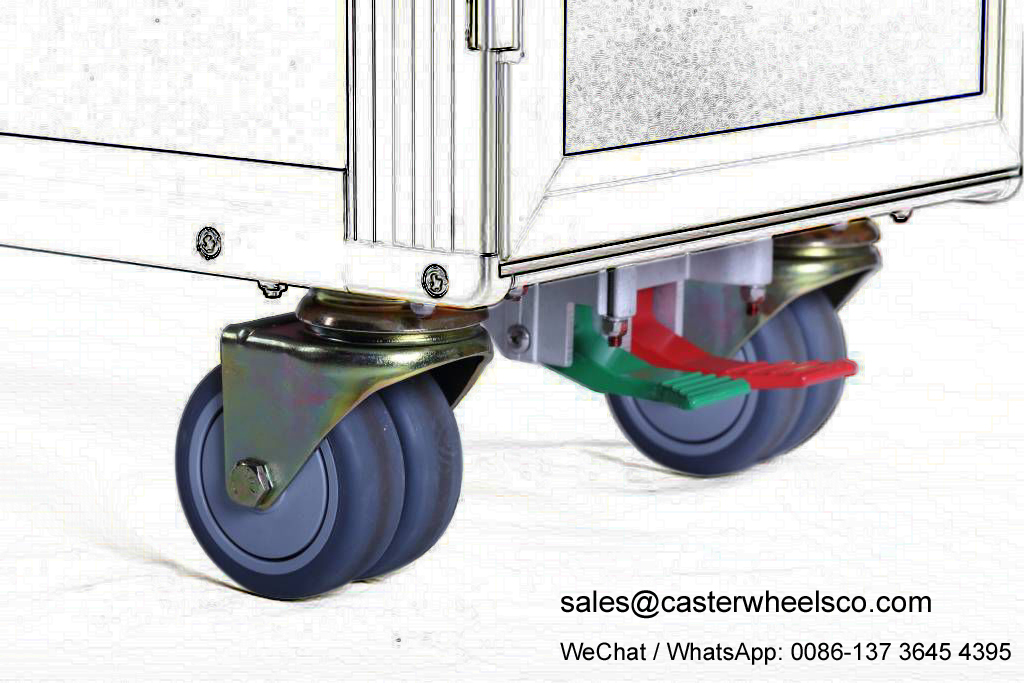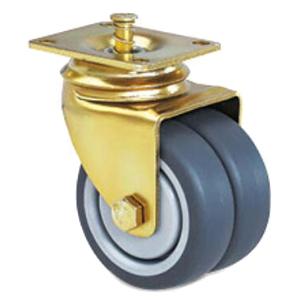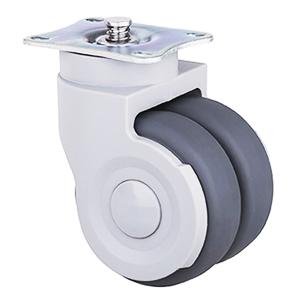Feature of airline trolley casters
Airline trolley casters are small but essential components that play a crucial role in the smooth operation of airline services. These casters attach to the bottom of airline trolleys, enabling them to be easily maneuvered and transported throughout the aircraft cabin. They have several key features that contribute to their functionality and performance, which we will explore in detail below.
1.Durability One of the most crucial features of airline trolley casters is their durability. These casters need to withstand frequent and heavy use, as they are responsible for supporting the weight of loaded trolleys, allowing them to be moved around the cabin with ease. Casters that are not built to last can cause significant problems, such as early failure, damage to the cabin floor, or even injury to cabin crew members.
To ensure durability, manufacturers use high-quality materials such as stainless steel or durable plastics in their caster production. Stainless steel offers excellent corrosion resistance, while plastics with high impact resistance are used to withstand heavy loads and rough handling. These materials provide resistance against wear and tear, ensuring long-lasting performance in demanding conditions. Additionally, many airlines use casters with reinforced brackets and axles, enhancing their strength and stability.
2.Load Capacity Airline trolleys carry a significant amount of weight, including food and beverage supplies, duty-free items, and other passenger essentials. Casters installed on these trolleys must be designed to handle these loads without compromising performance or safety. Casters with a higher load capacity can support heavier trolleys, ensuring stable movement and preventing accidents caused by unstable trolleys.
Load capacity is determined by several factors, including the number of wheels, wheel diameter, and the material used to make the wheels. Casters with larger wheels offer greater load capacity, as they distribute weight more evenly than smaller wheels. Manufacturers also often use materials such as polyurethane or rubber, which have excellent load-bearing properties, to ensure that the casters can support heavy loads without deformation or damage.
3.Smooth Rolling Another crucial feature of airline trolley casters is their ability to roll smoothly and quietly. Smooth rolling reduces noise levels in the cabin, which is crucial in maintaining a quiet and comfortable environment for passengers. It also makes it easier for cabin crew members to maneuver trolleys with minimal effort, reducing the risk of strain or injury.
To achieve smooth rolling, many manufacturers use ball bearings or precision roller bearings in their caster production. These bearings reduce friction between the caster and the floor, allowing for effortless rolling motion. Some casters are also designed with a swivel and turning function, which enhances their agility and flexibility in tight spaces.
4.Swivel Motion Airline trolley casters should allow for easy swiveling and turning in tight spaces. Cabin crew members often need to navigate narrow aisles and make sharp turns while pushing trolleys. Casters with swivel functionality enable smooth and agile movement, reducing the risk of collisions or damage to cabin interiors.
Swivel motion depends on the type of bearing used in the caster production. Ball bearings and precision roller bearings offer excellent swivel motion, allowing the caster to move in any direction with ease. Manufacturers also often use a swivel lock mechanism that enables the caster to be locked in a fixed position, ensuring stability and safety when the trolley is stationary.
5.Locking Mechanism To ensure trolley stability during flight, casters equipped with a reliable locking mechanism are essential. Lockable casters prevent unwanted movement when the trolley is stationary, such as during turbulence or when parked in specific areas of the aircraft. This feature enhances passenger safety and prevents accidents caused by unstable trolleys.
Locking mechanisms vary depending on the caster design. Some casters have a lever that locks the wheel, while others have a foot-operated brake. Manufacturers often use materials such as steel or durable plastics in their locking mechanisms, ensuring that they can withstand frequent and heavy use.

6.Lightweight Design Airlines are continually looking for ways to reduce their operating costs, including fuel consumption. One way to achieve this is by reducing the weight of onboard equipment, such as airline trolleys. Casters play a significant role in the overall weight of these trolleys, making it crucial for them to be lightweight.
To achieve a lightweight design, manufacturers often use materials such as aluminum or composite plastics in their caster production. These materials offer excellent strength-to-weight ratios, reducing the overall weight of the caster without compromising its performance or durability. Lightweight casters also make it easier for cabin crew members to handle trolleys, reducing the risk of strain or injury.
7.Anti-static Properties Static electricity can build up within an aircraft cabin due to various factors, including friction between surfaces. Anti-static casters help dissipate this built-up static charge, reducing the risk of electrostatic discharge that could potentially damage sensitive electronic equipment on board.
Anti-static properties are achieved by incorporating materials such as conductive rubber or carbon fiber into the caster production process. These materials enable the caster to conduct static electricity safely to the floor, reducing the risk of damage to electronic equipment.
8.Corrosion Resistance Airline trolley casters must be resistant to corrosion, as they are exposed to various liquids and cleaning agents during regular maintenance. Corrosion-resistant materials, such as stainless steel or galvanized coatings, protect the casters from rusting, ensuring their longevity and functionality.
Corrosion resistance is essential to ensure that the caster does not deteriorate or become damaged due to exposure to liquids or cleaning agents. It also ensures that the caster retains its appearance and performance over time.
9.Compliance with Regulations Airline trolley casters need to comply with industry regulations and standards, such as those set by aviation authorities and safety organizations. Manufacturers must ensure that their casters meet these requirements to ensure the safety and reliability of airline trolleys.
Compliance with regulations involves meeting specific design and performance standards set by regulatory bodies. For example, some authorities may require casters to undergo testing for load capacity, durability, before being approved for use in aircraft cabins. Manufacturers must adhere to these standards to ensure that their casters meet the necessary safety requirements.
In conclusion, airline trolley casters are vital components that contribute to the efficient and safe operation of airlines. They possess several key features that make them durable, functional, and safe, including load capacity, smooth rolling, swivel motion, locking mechanism, lightweight design,anti-static properties, corrosion resistance, and compliance with regulations. By incorporating these features into their design and manufacturing processes, caster manufacturers can provide reliable and high-performance products for the aviation industry.



 English
English Spanish
Spanish German
German Russian
Russian Arabic
Arabic Portuguese
Portuguese Italian
Italian French
French Hebrew
Hebrew Turkish
Turkish